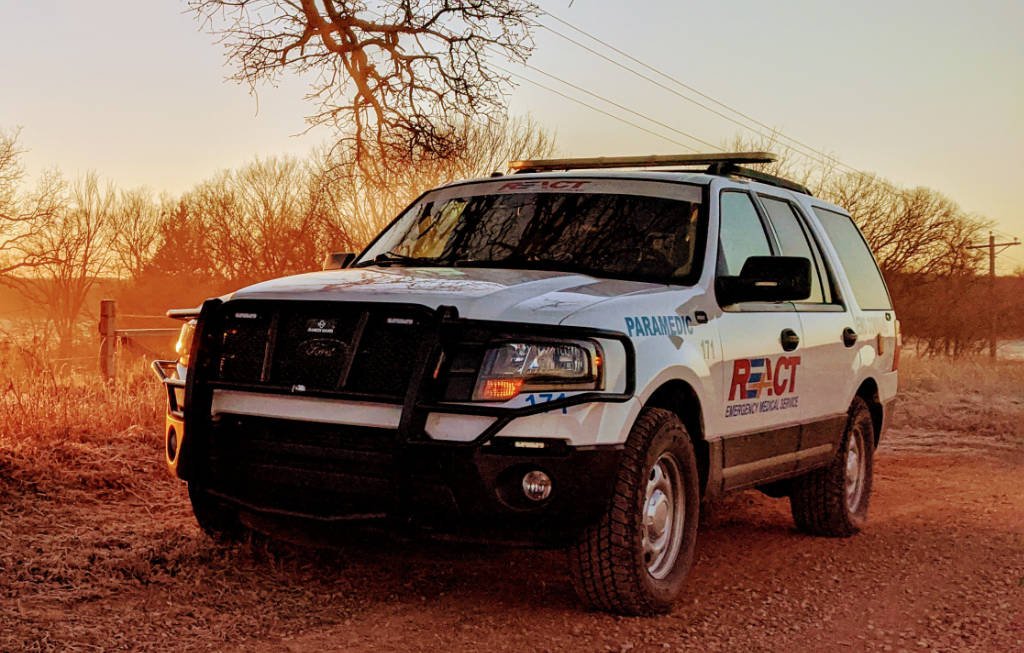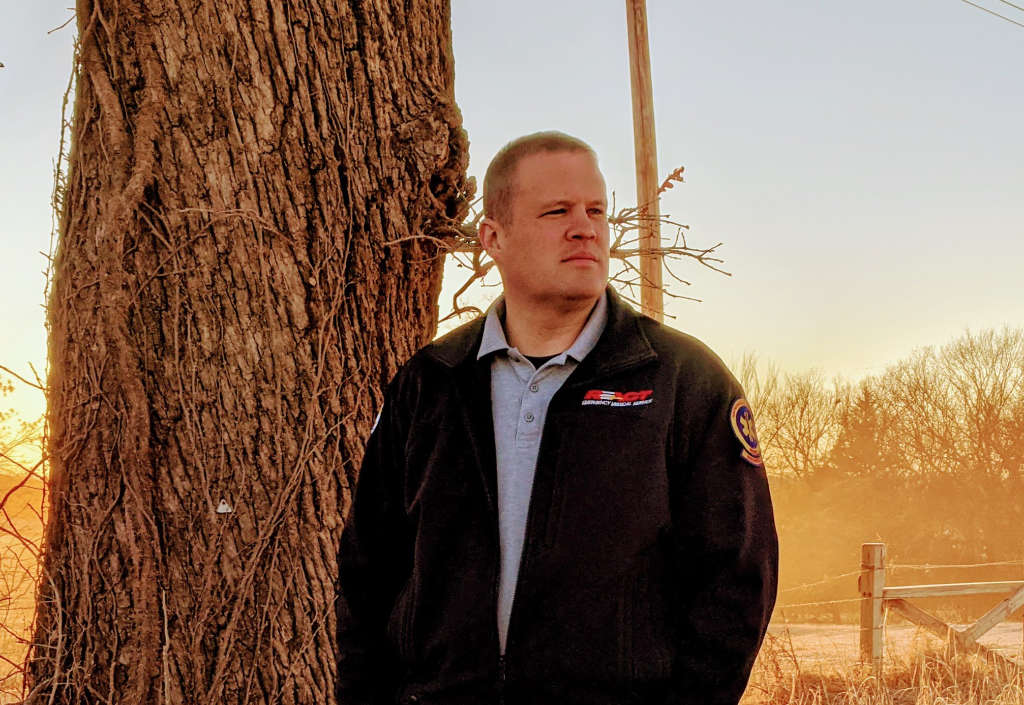
The emergency response unit with REACT EMS is in rural Oklahoma. (Photos by the author.)
By Matthew Bradshaw, NRP, CCP-C
As the sun creeps over the eastern horizon, Paramedic Erin O’Grady prepares to start his day as an emergency response unit (ERU) paramedic for the Oklahoma-based REACT EMS. The air is crisp, with a cold chill nipping at our ears, and I can see his breath in the air as he hauls each piece of equipment out of his ERU, placing it on a nearby workbench.
“It’s crucial that every piece of equipment is inspected before I start my shift,” says O’Grady. “If a piece of equipment fails, it could mean the difference between life and death for a patient.” O’Grady has been an ERU paramedic since the program inception, almost three years ago. As you’ll soon learn, his mission is unique.
Prior to March of 2017, a patient in Southern Pottawatomie County could have waited as long as 30-45 minutes before an ALS ambulance could make it to the scene to tend to their emergency. For years, many people asked: “Why not just have an ambulance stationed down here?” That solution, unfortunately, was not that simple. To have just one ALS ambulance assigned to the region would not have been cost effective, meaning it would have placed an undue tax burden on the members of the community.
Instead, the Pottawatomie County Commissioners and REACT came up with another solution, which was to have an SUV manned by a sole REACT paramedic equipped with all the necessary, lifesaving equipment stationed in the area. This unit would come to be known as the emergency response unit. It’s goal? To get to patients in this remote area, no matter the obstacles, within a matter of minutes and initiate emergency care.

Paramedic Erin O’Grady
Paramedic O’Grady is one of a handful of elite REACT paramedics who have met the strenuous requirements to be an ERU paramedic. An ERU paramedic’s role is unlike most paramedics who work in EMS. While most paramedics are paired with a partner and housed in a station, An ERU paramedic works alone out of their SUV. Inside, it has all the cutting-edge equipment that you would find in a modern day ALS ambulance, minus the ability to transport a patient. Instead, their job is to rapidly assess patients, initiate treatment, then stabilize the patient until an ambulance arrives to transport.
This can include obtaining vital signs, starting an IV, and giving medications. In a worst-case scenario, they may also need to establish an advanced airway on the side of a busy highway. There are times when they will get assistance from local volunteers from the surrounding rural communities, which O’Grady says is “truly a blessing.”
However, many of these volunteers are at their full-time jobs during the day, so they must be prepared to do it alone if necessary. “It’s one of the most challenging aspects of this position, having to multi-task and be resourceful,” he says. “It’s definitely made me a better paramedic, that’s for sure!”
The ERU’s response area is vast, covering 460 square miles of rolling prairies and winding roads, and its goal is to try and make it to an emergency scene within 10 minutes. Given this goal, it’s imperative that the ERU paramedic is very knowledgeable about the local geography. A traditional ambulance can have someone navigate while the other one drives. O’Grady doesn’t have that luxury. “I can’t drive and look at a map, so knowing the geography like the back of my hand is an absolute must,” he says.
Once the transport ambulance arrives on scene, the ERU paramedic will then assist the crew with preparing and loading the patient for transport. But what about the times when the area is so remote, with such limited access, that it is impossible for a traditional ambulance to make it to his location? O’Grady says this does happen from time to time, and it’s usually due to heavy rain causing the dirt roads in these remote areas to become undrivable.
“Without the capability of four-wheel drive, and the maneuverability of the ERU, there’s no way an ambulance can make it to them.” In these situations, he must do his best to improvise, which could mean loading the patient up in the back of the ERU himself, then bringing them to a rendezvous point the ambulance can safely access. “I’ve pretty much seen it all down here, and nothing really surprises me anymore,” O’Grady says.
When asked what he likes most about his role as an ERU Paramedic, O’Grady says it’s getting to interact with citizens of the local communities on a regular basis. When not responding to 911 calls, he can be found at one of the several senior citizen centers in the region performing wellness checks. They all know him on a first name basis.
“Erin is our guardian angel,” says one of the locals in the small town of Maud, Oklahoma. “If he is not tending to someone on an emergency call, he’s here at the senior citizen center, making sure our vital signs are doin’ good.” Paramedic O’Grady says his job is about much more than just taking care of patients. “To me, it’s very personal. I not only work down here; I live here. I’m taking care of my neighbors,” he says.
Willis Snowden, the EMS director for REACT EMS, says this is another great example of how the ERU program has proven to be an invaluable asset to the communities it serves.
“The response we’ve received from the citizens has been above and beyond what we ever expected,” he says. The program has been such a huge success that there is now hope that a similar program can be implemented in the northern region of REACT’s service area.
“Without a doubt, this model is a blueprint for citizens who live in rural communities where an ambulance is not able to respond within a reasonable time frame,” Snowden says. “It’s going to be an essential component of serving remote, rural communities not just here in our service area, but across Oklahoma and the United States.”



